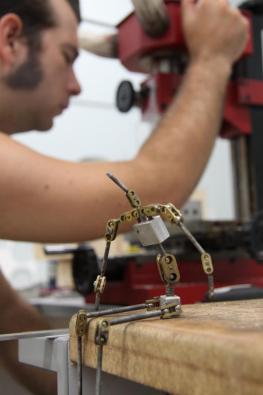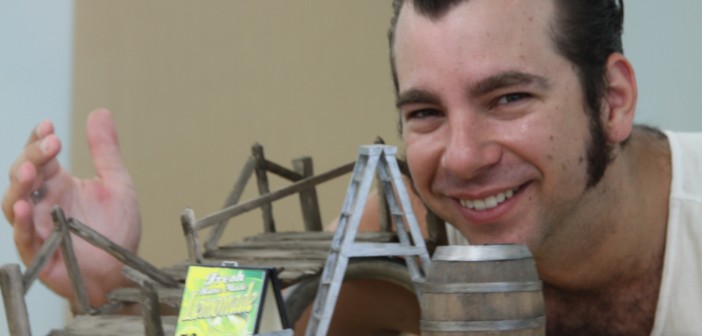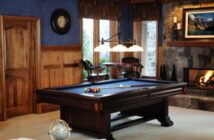So there was Al, sitting in a pub on a long weekend contemplating his next move as a stop motion (animation) film maker. Harry the Heater – the subject of Al’s film Keeping the Heat, who was sitting quietly in a bedroom workshop nearby – had won some accolade, but how could Al follow up a couple of minutes of claymation with something more substantial?
I guess that’s the question most film makers (or anyone with artistic pursuits) ask themselves: what next and how much better?
The project in the pipeline is The River Inside, an ambitious movie combining real footage with animation to investigate the way in which a man’s spirit can be temporarily crippled. In the film, the camera follows a tear back into a man’s body, where the animated world reflects the emotion and journey of sadness.
Harry the Heater would be proud. In that unmistakeable Aussie accent of his, he’d be telling Al that no matter what he does, “it’s nice to be appreciated.”

And Al knows this. There isn’t much of an animation scene in the Northern Territory where he is currently based; there’s few people making films and even less in the stop motion category.
That’s why it’s imperative that when this film maker is in film making mode, he is, to use his own words, “in the zone”.
Inside the zone
Al has been pondering the integrity of his art since he was a kid moulding clay models with his mum. “I just really liked making stuff and I developed that into a career,” he says. “I started where most animators start: with Lego pieces. They’re easy to use and you can do anything with them. It’s the first step before you move into more sophisticated creations.”
That kitchen table was the first zone, space if you like, where Al began developing his craft and enthusiasm.
“When I moved out of my parent’s place my father and I ripped up the carpet in my old bedroom and split the room down the middle. Half of it was used for my work desk and the other half was used for dad’s miniature train set. It worked well because we were both dealing in miniature and we could trade information.”
Working out of a bedroom paved the way for Al to learn to adapt to whatever space is available to conduct his craft. He looked at office spaces, but they let in too much light and so become the natural enemy of the animation film maker. Until recently the second bedroom, whether it was at his parent’s home or the house he rents with his wife, has been his cramped best friend.
“When I was making armatures (a metal skeleton that goes inside the puppet for structure and stability), it required a heap of metal working tools that I would have to set up and pack away again when a shot was finished.
“I’ve become good at working in stages, doing a complete tidy up and starting the next set piece. The bedroom kept me going for a long time; it’s where all of Keeping the Heat was shot.”
The new project requires a much larger space than Harry the Heater did. It is larger in cinematic scale and physical size. Creating The River Inside may have posed problems too large to overcome had it been attempted in a small bedroom.
As luck would have it, Al was offered a warehouse space; now he has the armature desk permanently set up at one end and three other benches at the other for set building and prop making. The warehouse has been generously donated for about five months.
“It’s enormous. I don’t know what the rent would be, but I know we couldn’t afford it.”

The colour of money
The problem for many animators is funding, or the complete lack of it. For too many, short film making is a labour of love that goes unrewarded and unsupported; it takes the generosity of those who donate warehouse space, for example, to keep the industry moving.
“There is no short film funding in the Northern Territory. Investors are looking for productions like Australia or Balibo; big name directors to showcase the Territory and bring in big name actors. I find it odd that this sector of the industry goes unsupported, because it’s where every big name director started. Short films are the bread and butter of the industry.”
Greenfield Productions (a partnership between Al and writer and ManSpace editor Jonathan Green) is waiting on an emergency response arts grant, but it is slow in coming. It is a $1,500 grant and Al says he would be eternally grateful for the help. In the meantime he has to find other means of income.
“We (animators and short film makers) keep ourselves busy and work other jobs. You try to do as close to the work you love as possible, while conducting your own projects on the side and waiting for Adam Elliott (producer, writer, animator and director of movies Mary and Max and Harvey Krumpet) to pick up the phone to call.”
Al has worked as a signwriter in the past, while another colleague is also a qualified nurse. Being skilled in other trades helps with finances, but the balancing act between pursuing the obsession, family life and making a buck is tricky; especially if the studio is in a bedroom.
“When I’m working on a film, I become heavily involved. However, during the slower times, I work as much as I can to build up a bankroll. I recently spent two and a half weeks working at the Darwin Festival. It gave me no time in the studio, but I have a nice back up that allows me to work in my own space for a month without looking for other jobs. It makes it difficult to buy a house and save money, but at the moment I am pursuing the very thing I love to do.”
He is prone to getting lost in his work, but by his own admission is not a ‘by myself’ kind of person. “I don’t do well by myself for extended periods, but this type of film making is a solitary experience; when I get into the zone I can lose hours animating.”
It means his wife often knocks on the door reminding Al to eat after six hours has passed and the miniature Harry the Heater has blinked more in that time. Al is under no illusion however, that in those hours the labour of his love can be difficult.
“There are some days where you feel every frame. When one thing has to happen and you do the same shot 60 times, it can do your head in and you want to throw the puppets across the room.”
Does the lack of funding make the situation worse? No, while he’s open to donations, the end result makes his labour worthwhile.
“I know I’m still emerging as an animator, but I also know I’ve done enough to be invited to work on major projects. That’s a good reason to keep going.”
Another reason is the end product. Al refers to his creations as little miracles.
“I don’t feel I’m a particularly good animator, but I love what I do and can look back at a shot and think ‘that’s amazing’ when a character comes to life. That’s the payoff. For the most part, I’m just amusing myself and occasionally people pay me to do it.”
Or they generously pick up a film to run at their festival. The River Inside has been picked up to open Darwin’s outdoor cinema season, known as Deckchair Cinema. Deckchair is a not-for-profit organisation that took a leap of faith, handed over $1,000 and will screen the film on their opening night in 2012.
“This kind of generosity encourages us to keep going. Jon and I held a trivia night to raise money and the response from friends was overwhelming: they came and said ‘here’s our money, go and make a film’.”

River of tears
Given the lack of overall financial support, you’d be forgiven for thinking that Al could occasionally drown in his own river of tears. It’s not the case. For this film maker the reason for being is to fulfil the goal of creating a shared experience.
“For me, it’s about the production of the film and telling a story that resonates and can be shared with others.”
While commercially the ultimate goal is to enter the film into festivals, win and be able to fund the next project, the personal goal is to tell strong stories.
“While we aim to make it viable, you can’t survive on that aim. We’ve missed more festivals than we’ve been invited to, however the desire to make movies surpasses that. We started the script for The River Inside six years ago and it’s great to see it finally come together.”
The stop motion process is a long one. It is unlikely that Al will be working from the same warehouse when the shoot is complete, but there is no doubt he will be in the same frame of mind.
“It shows the strength of Greenfield’s character as a company that we are prepared to see this through; that we care so much about the story that we want it to be told.”
For the next five months at least, Al will enter the warehouse knowing that he has a decent space to work in. It goes a long way to helping him turn his film into a reality. And even if he’s not in the warehouse, he has the courage of conviction to keep going until there’s a final reel and he has the satisfaction to yell “that’s a wrap” on The River Inside.

The stop motion process
The process of creating a stop motion film requires the combination of hard work and the patience of a saint. The animation is one piece of a very large puzzle that begins with a script.
Once the script is approved, the next step is to create a story board. Look at the shots involved, draw out individual movements and ensure the timing of those movements is correct.
Creating the scene is just as difficult: what needs to be in the scene, how will this be shot and how will the props be built?
Most of the time is actually spent on building the props. For instance one scene in Keeping the Heat required a flat piece of MDF for the floor. Odd shapes of cardboard were used on top and then plastered and painted. The walls were made of pre-fab brick that were also plastered and painted. A block of balsa wood was cut to create a set of wine barrels and a tree had to be sculpted and sized. A flashing necklace was used as fairy lights.
In other words, there are no shops to go to buy a miniature wine barrel (or whatever you need), so you have consider the best way to create one from raw materials that will ultimately look like a wine barrel under lights.
The Keeping the Heat set took two weeks to complete; it is a relatively short amount of time compared to other sets.
Finally, comes the animation, but the period of time between building and animation can be substantial. The skill of the animator comes from breathing life into inanimate objects one frame at a time. Each second of moving footage is made up of 24 individual still photos, run together in quick time. That literally means that the animator needs to take the puppet – and any other moving elements of the set – and adjust them a fraction at a time, taking a new photograph with each adjustment to create a realistic movement.




